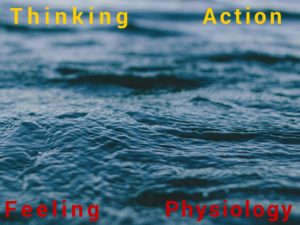Choice Theory and Behaviour
I recently attended a workshop presented by Lynn Sumida on William Glasser’s Choice Theory. She began by describing our four basic psychological needs, according to Glasser: Love & Belonging, Power, Fun and Freedom. (I covered these points in my previous article: Which is Most Important to You? Fun, Power, Love/Belonging or Freedom?)
She then went into behaviour and described how all behaviour is purposeful (and I would add, consciously or unconsciously driven) and all behaviour is INTERNALLY MOTIVATED. The reason we become motivated is that something on the inside matches with what we care about on the outside. Therefore, power struggles don’t work! She used the image of a scale to demonstrate the idea of one side holding the image of something that we want and the other side being the behaviours that we implement to get what we want. For example, if you really want a cup of coffee in the morning what are the behaviours you’re going to engage in to get that cup of coffee?
What is “Total Behaviour”?
According to Choice Theory, behaviour is made up of four components:
- Action
- Thinking We have direct control over these two
- Feeling
- Physiology We have indirect control over these two
We label the behaviour by the most obvious component. If you change any one of the four components, you’ll impact the whole system.
When people are upset, they’re caught in the bottom two components of feeling and physiology – as if they’re underwater. To come up “above water”, one needs to use the top two components: action and thinking.
We know from Cognitive Behavioural Therapy (CBT) and the treatment of anxiety, that thoughts create feelings. However, it is also important to remember that Action is the best and most efficient way of getting “above water” when one is drowning in feelings and the physiology that comes with those negative feelings. Examples of actions are: going for a walk or a run, cleaning the house or doing something else physical.
Lynn told the story of a principal, for whom she has great respect, who keeps a container of pens and pencils on the corner of her desk. If she is meeting with an upset parent, this principal “accidentally” knocks over the pens and pencils. The action of them both picking up all the fallen objects, affects the parent’s whole system and the parent is able to come up “above water”.
Another strategy, this principal uses is asking the parents to walk and talk with her as she “needs” to give a message to the librarian or gym teacher. Of course these strategies work for children too. If your child is really upset, we know from Dan Siegel’s work, that we can’t go into left-brain logical problem solving until the right-brain emotions have calmed down. We can validate the child’s feelings, give him/her a hug but also going for a walk or engaging in some other form of physical activity shifts the “Total Behaviour”.
Discipline vs. Punishment
Discipline is “to teach” – to frame one for learning. Discipline ultimately builds the relationship. Punishment is not collaborative and destroys the relationship. Punishment creates resentment. It’s important to encourage children/youth to be presented with choices in order that they learn to think for themselves. As Jim Skinner, Executive Director of the Vancouver Adlerian Centre says: “If you don’t give children responsibility they won’t become responsible”.
Rules vs. Values
Lynn also presented Robert Dilts pyramid of Rules vs. Values. She also added Emotions to the Behaviour level and explained that one can’t use rules to develop beliefs and values. Rules are the bottom two levels: Environment and Behaviour/Emotions. Rules are necessary for safety. She recommends not setting curfews with your teenagers as this doesn’t teach them to think for themselves. They need to listen to themselves and recognize when a situation might be too risky or not a “good-fit”. They need to be able to leave a party because they get a strong sense that this doesn’t feel right (ie. Doesn’t fit with their values) vs. it’s my curfew time.
We need to teach our children to be critical and reflective thinkers. We need to role model our beliefs and values and have discussions about our family values. Each family has their own beliefs and values, for example in relation to video games. Some families are okay with their elementary school-age child playing M rated video games, I am not. My husband and I tell our children that this is our family value and explain our reasons. As teenagers they are going to need to make responsible choices and they are going to socialize with peers who have different values. It is important for them to be clear about their values and how to resist peer pressure.
Hope you have an active and positive thinking, feeling, healthy physiological kind of week!
Warmly,
My 6 Top Apps for Creating More Calm for You and Your Children!
Want to Connect?
Subscribe now to receive free weekly parenting tips and inspiration.








